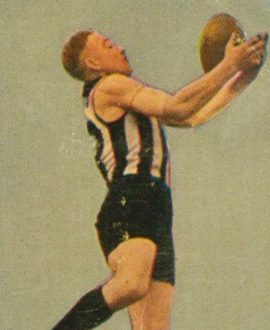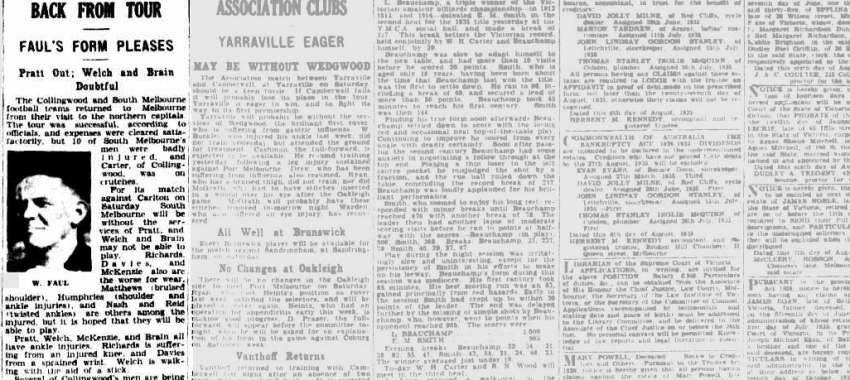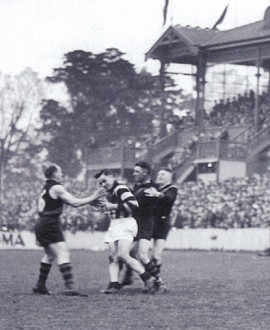Albert Collier was one of the most famed – and feared – footballers of his generation. He was also one of the greatest.
He won a Brownlow, three Copelands, played in six Premierships and would later be inducted into both the Collingwood and AFL Halls of Fame. Together with his older brother Harry, he would become the soul and spirit not just of the famed Machine teams of 1927-30, but also that group’s second incarnation that played in five successive grand finals in the mid-to-late 1930s.
This staggering career started at a precociously young age. Albert and Harry did everything together as kids. They went to school together, played sport together, knocked around at the Collingwood ground after school together and sold footy records at the ground on Saturdays together.
Albert was the younger by about 15 months, and by his teens was already showing prodigious sporting talents. He captained the State’s schoolboy football and cricket teams, in the latter of which he was chosen as first wicketkeeper ahead of a young Ben Barnett, who would later tend the stumps for Australia. Albert could also bat and bowl, making a few runs with the Collingwood first XI as a 16-year old and once taking the wickets of State players Frank Baring and Albert Hartkopf with what his brother described as “leg breaks that didn’t turn”.
Widely known as ‘Leeter’ (nobody is too sure why, but legend has it that when he was born an Italian neighbour shouted that the newborn was “a little boy”, but with her native dialect it came out sounding like “leeter boy”), he followed Harry to Ivanhoe when he left school. Harry won a best and fairest award, and that was enough to earn him a trial at Collingwood. Luckily, he took his ‘little’ brother with him.
The first practice match was a revelation, with Albert kicking half a dozen goals from full-forward and Harry four from a half-forward flank. Harry then suffered some knee problems which temporarily halted his climb to the top, but Albert continued to impress. He was chosen at full-forward against Essendon in the first game of the 1925 season — at the tender age of 15 years and nine months.
Albert played only a few games that year, spending most of the season at full-forward in the seconds. Brother Harry returned from injury in time for both to be part of the seconds’ Premiership team, the first in a long line of joint successes for the siblings.
In 1926 there was no stopping them. With Gordon Coventry having secured his previously precarious hold on the full-forward spot, Albert was moved to centre half-back.
And what a difference the move made! Collier played every game that year, won selection in a Victorian side that played the Ovens and Murray League and began to carve out a reputation that would finish up as big as the man himself.
At centre half-back Collier quickly established himself as one of the most respected and feared footballers in the competition. Although young, he was very, very strong and even at that stage was showing a liking for the rugged exchanges. From his very first appearances he had a “presence” on the field matched by few others. It unsettled opponents and gave his comrades confidence. He was not as tall as many people thought, not quite making it to 180cm. But he was robust, had massive shoulders that hurt when they hit, and he played like a much bigger man.
He was a good mark with a terrific leap, and he was always looking to sprint away from opponents (he did some professional running during the summer months) and deliver the ball with a long kick into the forward line. In those days this was regarded as risky play for a defender, and only to be attempted by those with superb judgement. Albert had that judgement, and seemed to know when to spoil, when to fly for a mark and when to dash forward. Harry Collier once said that, even putting brotherly love aside, Albert was “simply the best”. “He could do anything,” he said. “Run, mark, kick either foot, handball, turn — and to top it all off he was just about the toughest player you’d ever see.”
In 1929 just about everybody, including the umpires, agreed. Albert won the Brownlow Medal, the Copeland Trophy and interstate selection. Still aged only 20, it looked as if there were no limits to what he might achieve.
But the Great Depression intervened. Unable to find work in Melbourne and unhappy with the money he was getting from football, Albert took a coaching job in Tasmania for seasons 1931 and 1932. He won the Leitch Medal for the League’s best and fairest there, and also coached his team Cananore to a Premiership.
When he was found a job as a painter at Carlton and United Breweries he came back to Collingwood, where he embarked on a quite distinct second phase of his career. The dashing centre half-back had developed into a tough and rugged follower who assumed the role of team “protector”.
It is doubtful if Collingwood has ever had a player better suited to such a role. No physical effort demanded of him was too much where Collingwood was concerned, and he threw himself into packs fearlessly. He possessed perhaps the most feared hip-and-shoulder in the game, and opponents who dared stand in his way were often left lamenting their carelessness.
So too were opponents who tried to intimidate Collingwood’s younger or smaller players. Leeter had an intense loyalty to his teammates, and he became well known for his liberal use of muscle in defence of his colleagues.
In his post-Tasmanian incarnation, Collier was a quite different player. Although he was still capable of brilliance around the ground he sacrificed much of his own game to the interests of the team. The spectacular marks and clearing dashes downfield became less frequent, being replaced by more ruckwork and “hard yakka” in support of teammates. Ron Todd later wrote in The Sporting Globe that Albert Collier was the best follower he had seen.
In his new role of protector and team leader he played a brand of football that made him even more important to the team’s fortunes. He was possibly the most valuable footballer in the competition. He won the Copeland Trophy in 1934 and again in 1935, was a regular Victorian player and also won other awards including one from radio station 3KZ for the most popular player of 1937.
Off the field Albert was something of a rough diamond. There was not a lot of polish about him but he was a straight, no-nonsense bloke with a kind heart. He would call a spade “a bloody shovel”, and it did not pay to get on his wrong side. He was also viewed in some quarters as a bit of a rebel, and was an early defender of players’ rights off the field as well as on. Most of the players idolised him.
By 1938, though, injuries started to take their toll. He missed most of the season with a knee injury which later required surgery, and was troubled by the same complaint in 1939. After the final practice match of 1940 the Collingwood committee decided Leeter (and Harry) should retire. Albert was bitterly disappointed by the decision, as he still felt there was some football left in the old legs yet. He played 11 games at Fitzroy in 1941, then had a successful coaching stint with Camberwell in the VFA before coaching in country centres Kyneton and Sea Lake.
In 1960 he again hit the headlines when he lay in a bulldozer’s path to prevent trees from being knocked down on the Carrum foreshore. If that had happened during Albert Collier’s playing days there would have been plenty of opponents prepared to wager that the bulldozer might have come off second best.
Brilliantly talented, super tough and inspirational in equal measure, Albert Collier had it all – and he still stands as one of football’s all-time greats.
- Michael Roberts






